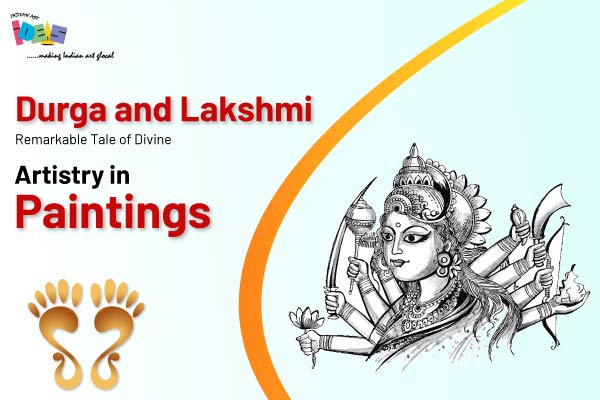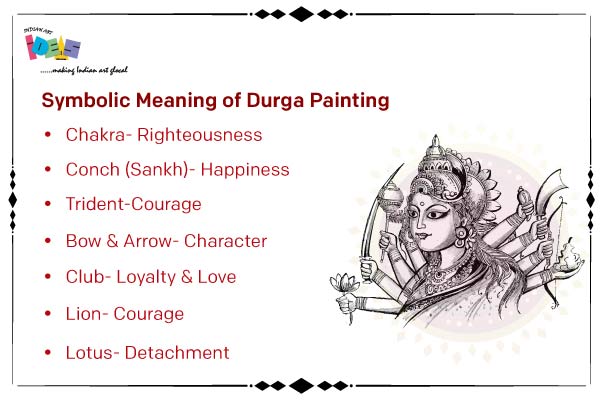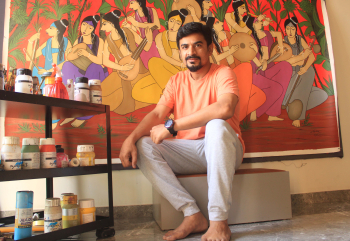
In the realm of artistry, where strokes of imagination meet the canvas of spirituality, there exists a captivating tale of divine expression. It's a story woven not just with paint but with passion, devotion, and the essence of two revered goddesses. Durga and Lakshmi—two goddesses who stand at the pinnacle of Hindu mythology. Durga, the warrior goddess, embodies courage and strength, while Lakshmi, the goddess of wealth and prosperity, radiates luxury and abundance. Their presence in art transcends mere imagery; it's a conduit for spiritual connection and contemplation. In this blog, let's delve into the mystical world of Lakshmi and Durga paintings, where each stroke tells a tale of faith, grace, and power.
Goddess Durga and Her Significance in Hindu Mythology
In the vast tapestry of Hindu mythology, Goddess Durga emerges as a vibrant and multifaceted deity. She embodies the spirit of power, courage, and divine protection. Durga, often depicted riding a fierce lion or tiger, is revered for her ability to combat evil forces and maintain cosmic order. Her name, "Durga," itself signifies invincibility.
Durga's significance is intricately interwoven with the grand Hindu epic, the Mahabharata. According to mythology, she was created by the combined energies of various gods to defeat the formidable demon Mahishasura, whom any single deity could not defeat. Her victory in this epic battle symbolizes the triumph of good over evil, righteousness over chaos.
Beyond her warrior aspect, Durga is also celebrated as a mother goddess, representing maternal love and compassion. During the annual festival of Durga Puja, devotees across India and the world honor her with elaborate rituals, processions, and artistic representations. Her image, often depicted with ten arms holding different weapons, exemplifies her role as a protector and defender of dharma, the moral and ethical order of the universe.
Goddess Lakshmi and Her Role in Hindu Culture
In contrast to the resolute and fierce Durga, Goddess Lakshmi graces Hindu culture as the epitome of grace, beauty, and abundance. She occupies a unique and cherished position in the hearts of her devotees, being revered as the embodiment of wealth, prosperity, and favorable blessings. Her name is intricately entwined with opulence and favorable circumstances, firmly establishing her as a central and influential figure within the realm of Hindu customs and beliefs.
In artistic representations, Lakshmi is often portrayed gracefully seated or standing upon a lotus flower, a powerful symbol of purity and transcendence. What adds to her symbolism are her four hands, each carrying profound significance. These four hands embody the fundamental aspirations of human life: Dharma (duty), Artha (prosperity), Kama (desire), and Moksha (liberation). It embodies the idea that material wealth should be pursued with ethical and moral principles.
In Hindu culture, the worship of Lakshmi is central to Diwali, the festival of lights and prosperity. It is believed that on Diwali night, Lakshmi visits homes and blesses them with wealth and good fortune. Her presence in homes and businesses is considered a precursor of success and abundance.

Artistic Interpretations of Goddess Durga
The artistic representations of Goddess Durga are as diverse and rich as her mythology. Artists across centuries and cultures have sought to capture her multifaceted essence through their brushes, resulting in a stunning array of interpretations.
In one portrayal, Durga emerges as the fierce "Mahishasura Mardini" (the slayer of the buffalo demon), her ten arms wielding a variety of weapons. It symbolizes her formidable strength and courage. Her expression is one of unwavering determination, showcasing her as a protector of the innocent. Alternatively, in some Durga paintings, artists choose to emphasize her maternal side, depicting her as "Durga Ma" (Mother Durga). In these renditions, she cradles her children, Ganesha and Kartikeya, in a loving embrace, radiating compassion and maternal warmth.
The use of vibrant colors in Durga's attire and surroundings often symbolizes her vitality and power. The image of her riding a majestic lion, her mount, signifies her dominion over both the gentle and the ferocious aspects of life. Durga's depiction can also vary in regional art forms. For instance, in Bengal, where Durga Puja is a grand festival, artists often emphasize her ornate jewelry and intricate accessories, underscoring her divine beauty and grace.
Symbolism and Elements Commonly Found in Durga Painting
Goddess Durga paintings are a canvas of symbolism, each element carefully chosen to convey deeper meanings. The lion, her vahana (vehicle), represents courage, while the slain demon symbolizes the triumph of good over evil. Her multiple arms signify her ability to multitask and offer help to those in need. The third eye on her forehead symbolizes her omniscience, seeing beyond the physical realm.
Goddess Durga is often depicted with a serene countenance amidst a raging battle, symbolizing inner peace and strength amid chaos. Her trident, sword, and conch shell are symbolic of her role as a warrior goddess. The lotus she holds signifies purity, while the rosary embodies meditation and spirituality. Durga's paintings are incomplete without the "bindi" on her forehead, denoting the divine third eye.

Artistic Portrayal of Goddess Lakshmi
Goddess Lakshmi is often depicted in art as the embodiment of wealth and abundance. Artists skillfully capture her radiant persona, portraying her with lustrous, almond-shaped eyes that exude compassion. Her complexion, resembling the glow of gold, symbolizes her association with prosperity.
What truly sets Lakshmi's paintings' portrayal apart is her adornments. She is adorned in radiant jewelry, signifying her status as the goddess of wealth. Her four hands hold symbolic items—a lotus, symbolizing purity; a pot of gold, representing wealth; and two more hands gesturing blessings and protection.
Symbols and Attributes Associated with Lakshmi in Paintings
In Lakshmi paintings, each element serves as a visual narrative. The lotus she holds is a symbol of purity and detachment, as it grows in muddy waters yet remains untainted. It emphasizes that wealth should not corrupt one's character. The overflowing pot of gold symbolizes not just material riches but also spiritual wealth. Lakshmi's blessings encompass both material prosperity and inner abundance. Her two other hands are poised in mudras (hand gestures) that convey specific meanings. The Abhaya Mudra, with the raised palm, signifies her role as a protector, assuring devotees of safety. The Varada Mudra, with the handheld downward, represents her bestowing boons and blessings upon her worshippers.
Read More: Durga Paintings And Its Significance
Various Artistic Styles Used to Depict Durga and Lakshmi
Artistic styles are the distinct approaches artists take when representing Durga and Lakshmi, breathing life into their divine forms. These styles are as diverse as the deities themselves, each offering a unique perspective on their essence.
1.Classical Realism
In the world of art, classical realism reigns supreme when it comes to portraying in Durga and Lakshmi paintings. This style emphasizes precision, attention to detail, and an almost photographic representation of the goddesses. Artists employing this technique aim to capture every intricate feature, from the gentle curve of Lakshmi's lotus to the fierce expression on Durga's face.
2.Abstract Expressionism
On the other end of the spectrum, some artists choose abstract expressionism to convey the mysticism surrounding these goddesses. With bold brushstrokes and vibrant colors, they create paintings that evoke emotions and invite interpretation. In these works, Durga and Lakshmi transcend the literal, becoming symbols of spiritual energy and transcendence.
3.Impressionism
Impressionist painters infuse their Durga and Lakshmi paintings with a sense of movement and immediacy. Through the use of light and color, they convey the fleeting nature of divine presence, as if capturing a momentary glimpse of these goddesses amidst the celestial realms.
Discuss the Techniques Artists Employ to Capture the Divine Essence
Artists who undertake the task of portraying Durga and Lakshmi grapple with the challenge of encapsulating their divine essence. It involves a combination of techniques that go beyond the canvas, reaching into the very heart of spirituality.
1.Symbolism
One of the foremost techniques is the use of symbolism. Every element in the painting, from the weapons Durga wields to the gold coins cascading from Lakshmi's hand, carries profound symbolic significance. Artists employ these symbols to convey the goddesses' attributes and powers, allowing viewers to connect with the deeper meaning.
2.Light and Shadow
The interplay of light and shadow is a powerful technique to create depth and dimension in these artworks. By skillfully illuminating and shading different aspects of the deities, artists can evoke a sense of presence and transcendence, as if Durga and Lakshmi are radiating divine light.
3.Texture and Layering
Texture and layering techniques add depth and tactile quality to the paintings. Whether it's the smoothness of Lakshmi's skin or the rugged texture of Durga's lion, artists use these techniques to make the goddesses feel tangible, bridging the gap between the earthly and the divine.
Interesting Blog: Lakshmi Paintings for Home Décor
How Colors, Composition, and Brushwork Contribute to the Impact of the Paintings?
Colors, composition, and brushwork are the soul of Durga and Lakshmi paintings. They dictate the emotional resonance and visual impact that these artworks have on viewers.
1.Colors
The choice of colors is deliberate and symbolic. Rich golds and vibrant reds in Lakshmi paintings symbolize wealth and passion, while the earthy tones in Durga paintings evoke strength and courage. The colors set the emotional tone of the artwork, enveloping the viewer in a specific mood and atmosphere.
2.Composition
Composition is the arrangement of elements within the painting. Artists carefully position Durga and Lakshmi, as well as surrounding motifs, to create a harmonious balance that draws the viewer's eye. It's through composition that artists guide the viewer's focus towards the divine aspects of the goddesses.
3.Brushwork
The technique of brushwork can vary from bold and expressive strokes to delicate and intricate details. It's through the brushwork that artists infuse life and energy into their creations. Bold strokes may convey Durga's ferocity, while delicate lines can capture Lakshmi's grace.
Wrapping Up
The divine Lakshmi and Durga paintings are not just a visual feast but a spiritual pilgrimage for the soul. It is a reminder of the profound values they represent—courage, strength, wealth, and prosperity. In a world often marked by chaos and materialism, these artistic expressions serve as beacons of hope and inspiration. They underscore the need to embrace spirituality, honor tradition, and seek the divine in the midst of our modern lives.
Our commitment to artistry extends beyond the canvas, and we take pride in infusing life into divine representations. Whether it's a masterpiece inspired by Durga's fierce determination or Lakshmi's timeless grace, our artists craft art that resonates with your spirit.
FAQs
What is the significance of Durga paintings in Hindu culture?
Durga paintings hold immense significance as they depict the warrior goddess's courage and her role in defeating evil, symbolizing the triumph of good over bad.
What does Lakshmi's representation in paintings signify in Hindu culture?
Lakshmi's portrayal in paintings symbolizes wealth, prosperity, and the bestowing of blessings upon homes and businesses.
What artistic styles are commonly used to portray Goddess Durga?
Artists often employ classical realism, abstract expressionism, and impressionism to capture the multifaceted essence of Goddess Durga.
Are there contemporary artists who specialize in reimagining Durga in modern contexts?
Indeed, several contemporary artists explore reimagining Durga to reflect contemporary themes and issues, adding a fresh perspective to her portrayal.
Are Lakshmi paintings primarily for religious settings, or can they enhance home decor?
Lakshmi paintings serve both spiritual and decorative purposes, making them suitable for homes, businesses, and temples.






















